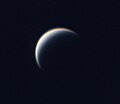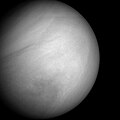This article includes a list of general references, but it lacks sufficient corresponding inline citations .(January 2015) |
 Artist's impression of the five components of Pioneer 13 approaching Venus | |
| Names | Pioneer Venus 2 Pioneer 13 |
|---|---|
| Mission type | Venus atmospheric probes |
| Operator | NASA / Ames |
| COSPAR ID | 1978-078A |
| SATCAT no. | 11001 |
| Website | science.nasa.gov |
| Mission duration | 4 months and 1 day |
| Spacecraft properties | |
| Bus | HS-507 |
| Manufacturer | Hughes |
| Launch mass | 904 kilograms (1,993 lb) [1] |
| Dry mass | 290 kilograms (640 lb) (bus) 315 kilograms (694 lb) (large probe) 3 x 90 kilograms (200 lb) (small probes) |
| Power | 241 W |
| Start of mission | |
| Launch date | August 8, 1978, 07:33 UTC [1] |
| Rocket | Atlas SLV-3D Centaur-D1AR (AC-51) |
| Launch site | Cape Canaveral LC-36A |
| End of mission | |
| Last contact | December 9, 1978, 20:22:55 UTC (main bus) December 9, 1978, 20:55:34 UTC (Day probe) |
| Orbital parameters | |
| Reference system | Heliocentric |
| Semi-major axis | 0.9 astronomical units (130,000,000 km; 84,000,000 mi) |
| Eccentricity | 0.19 |
| Perihelion altitude | 0.69 astronomical units (103,000,000 km; 64,000,000 mi) |
| Aphelion altitude | 1.01 astronomical units (151,000,000 km; 94,000,000 mi) |
| Inclination | 2.3 degrees |
| Period | 284.0 days |
| Venus atmospheric probe | |
| Spacecraft component | Large Probe |
| Atmospheric entry | December 9, 1978, 18:45:32 UTC |
| Impact date | 19:39:53 UTC |
| Impact site | 4°24′N304°00′E / 4.4°N 304.0°E |
| Venus atmospheric probe | |
| Spacecraft component | North Probe |
| Atmospheric entry | December 9,1978,18:49:40 UTC |
| Impact date | 19:42:40 UTC |
| Impact site | 59°18′N4°48′E / 59.3°N 4.8°E |
| Venus atmospheric probe | |
| Spacecraft component | Day Probe |
| Atmospheric entry | December 9,1978,18:52:18 UTC |
| Impact date | 19:47:59 UTC |
| Impact site | 31°18′S317°00′E / 31.3°S 317.0°E |
| Venus atmospheric probe | |
| Spacecraft component | Night Probe |
| Atmospheric entry | December 9,1978,18:56:13 UTC |
| Impact date | 19:52:05 UTC |
| Impact site | 28°42′S56°42′E / 28.7°S 56.7°E |
| Venus atmospheric probe | |
| Spacecraft component | Main bus |
| Atmospheric entry | December 9,1978,20:21:52 UTC |
The Pioneer Venus Multiprobe,also known as Pioneer Venus 2 or Pioneer 13,was a spacecraft launched in 1978 to explore Venus as part of NASA's Pioneer program. This part of the program included a spacecraft bus which was launched from Earth. The bus carried one large and three smaller probes,which,after separating,each penetrated the Venusian atmosphere at a different location,returning data as they descended into the planet's thick atmosphere. The entries occurred on December 9,1978.










